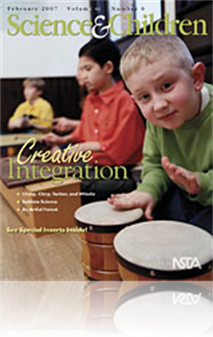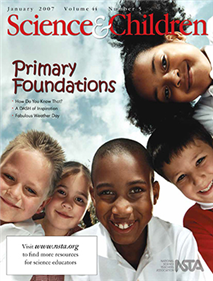All Science and Children resources
Journal Article
Resourceful Science Integration
Recognizing that many issues of Science and Children contain helpful and varied examples of science integration that might be pertinent to a particular classroom setting, we decided to compile an annotated bibliography using issues from the last 12 y...
Journal Article
Cheep, Chirp, Twitter, & Whistle
In this article, we describe an interdisciplinary, activity-based lesson plan implemented in a third/fourth-grade classroom. During these activities, students use musical concepts to think about, illustrate, and discuss animal behavior, and they us...
Journal Article
The Early Years: Birds in Winter
Science and art go hand-in-hand, as scientists make art to share their observations. Two scientists who are widely known first as artists are Leonardo de Vinci, anatomist and inventor, and Beatrix Potter, mycologist. Both of these scientists used obs...
Journal Article
Learning makes more sense and is retained when it has a context and connection to other knowledge. We know this from a wealth of sources: research, our experiences as students—and as teachers. We remember things that have a rich set of connections....
Journal Article
Perspectives: Connecting with Other Disciplines
Interdisciplinary instruction is a way of approaching curriculum by organizing content and processes from more than one discipline around a central theme, issue, problem, topic, or experience (Jacobs 1989). Teachers can start the process of designing...
Journal Article
Understanding cyclic patterns and distinguishing them from other patterns is critical to understanding the Earth and beyond. Whether you are discussing star cycles, rock cycles, life cycles, or carbon cycles, this is the stuff of science. It is a fun...
Journal Article
The Early Years: Light Foundations
The day-and-night cycle forms the basis for understanding many other natural cycles in plants, animals, and Earth processes, as well as later learning about the solar system, and it is part of the National Science Education Content Standard D, Earth ...
Journal Article
Methods and Strategies: Discussion Maps Make Sense!
One warm spring day, a group of 18 young children sat in a classroom discussing their ideas about plants. This was one of several discussions in a multi-age, grades 1–3 classroom in which the children were talking about living things. The plant dis...
Journal Article
Children do not have to live near the coast to experience effects of water waves. They can throw stones into a pond and see the waves ripple outward, bob up and down while floating in a swimming pool, and splash water about while in a bathtub. As stu...
Journal Article
The purpose of many animal studies at early grades is to build observation skills, develop a knowledge base, and practice age-appropriate science skills like comparing, describing, and drawing. While these are important learning experiences, the Nati...
Journal Article
Perspectives: Examining the Learning Cycle
Cognitive scientists tell us that students need to relate new ideas to their experience and place new ideas into a framework for understanding (Bransford, Brown, and Cocking 2001). Thus exploring phenomena before explaining them is critical for learn...




